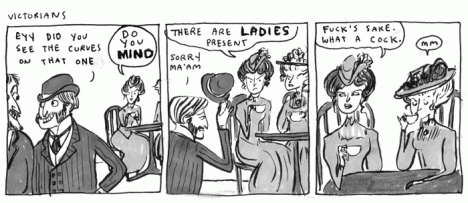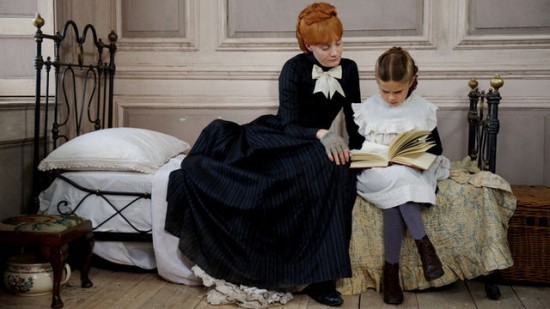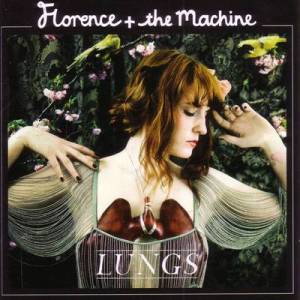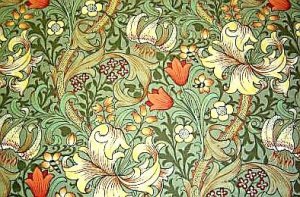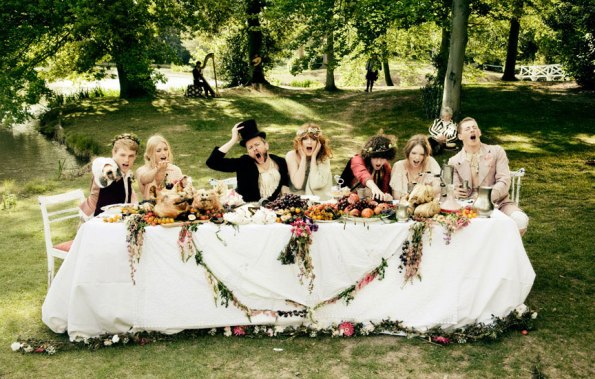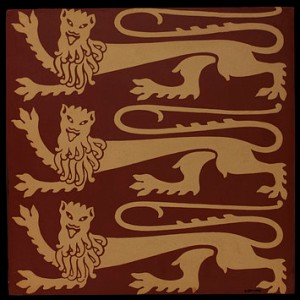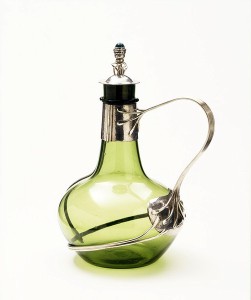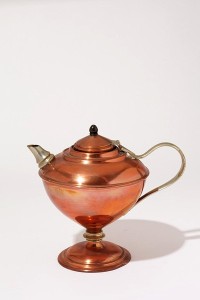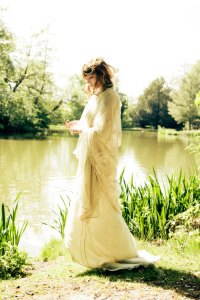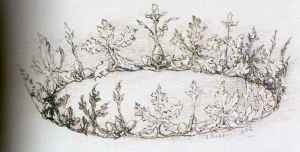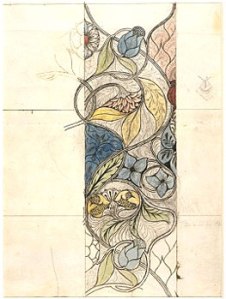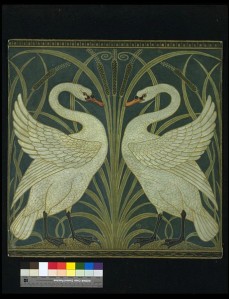On the weekend, while taking a break from writing lectures, the Nerd introduced me to Stacking! A longer post is coming, in which we’ll take a look through the use of neo-Victorian (and.or Steampunk) Things in the game, but for now: feast the eyes!
Your tea break this morning should really be spent in horrified contemplation of this blog post from Feministe.us, which details some of the recommendations made by Barkham Burroughs in his Encyclopaedia of Astounding Facts and Useful Information. Burroughs exhorts women to put soapsuds in their eyes, bathe in ammonia (probably best not to confuse those last two suggestions), briskly brush themselves down with stiff bristled brushes and – last but not least – dance naked in the sunshine.
Burroughs is inexplicably silent on what men should do, but I can think of a few. Bleach their moustache tips, perhaps?
You can get the full text – and why would you not want to do that? – from archive.org. You will have instantly at your fingertips solutions for almost every problem that may beset the human, such as ‘serpent bites’ and ‘bleeding’ from almost every orifice and organ. A personal favourite is the entry on ‘How to Distinguish Death’ which is included due to the many many instances of ‘parties being buried alive, they being to all appearance dead’. No ride on the Necropolitan Line for you, you ‘imaginary dead’! Only the ‘truly deceased’ get to go!
On a more serious note, the Encylopaedia functions as an excellent guide to the many solvents, poisons, ‘medications’ and other chemical wonders to which the Victorians clearly had access in liberal quantities. Anyone who winces at The Crimson Petal and the White‘s homemade abortifacent of zinc sulphate, among other nasties not intended for vaginal douching, would do well to consult Burrough’s loving catalogue of the endless ways in which you can do yourself harm.
And on that note, a little bit of dancing naked in the (much wished-for, late-but-still-welcome) sunshine is clearly required!
‘Pretty soon’ did not quite go to plan. I’ve spent a lot of time on trains – no good for writing but good for reading! As it comes to an end, let me Think about the Things I have read in July and August:
Mark Forsyth – The Etymologicon: A Circular Stroll Through the Hidden Connections of the English Language (2011): I was always going to like this, wasn’t I? Much like this blog, it does exactly what it says on the tin, meandering across the interesting corners of the English language. Will definitely provide at least one of the Fascinating Facts of the Day on this blog – it’s that kind of book. But the format does it no favours at all – far too list-like to be a truly comfortable read. Bill Bryson might not be better at etymology itself, but he is better about writing about it.
Emma Donoghue – Room (2010): Personally I found this disappointing; perhaps because I’d been told a lot of fantastic things about it and was expecting something quite different.
Jennifer Egan – Look at Me (2002, relaunched 2011): A less-than-successful first novel, this has been given a massive publisher push because of Egan’s recent success with A Visit from the Goon Squad (2011). Largely an interesting premise – a model smashes every bone in her face in a car accident; the resulting reconstructive surgery leaves her beautiful but unrecognizable to anyone who knew her ‘before’ – this doesn’t always convince. The strands of the narrative hang loosely together, connected by a character whom Keegan seems to have set out to make thoroughly unlikeable, but doesn’t always have the guts to see it through. Similarly, you can see the joins in Egan’s self-conscious ‘purple passages’, normally when she’s considering Americana.
SOUND THE NEO-VICTORIAN KLAXON!
Broadmoor Revealed: Victorian Crimes and the Lunatic Asylum – Mark Stevens – pretty good, particularly for a short book compiled by an archivist that is free on Kindle. Inevitably neo-Victorian, in that it ‘discovers’ intriguing information about four notorious Victorian figures. There isn’t as much reference to the Victorian perception of mental illness as I’d like, and the text is curiously silent about the treatments that were considered effective.
The Invention of Murder: How the Victorians Revelled in Death and Detection and Created Modern Crime – Judith Flanders (2011) – A whacking great doorstop of a book that saw me through a solid week of travel. It’s great stuff from Flanders, who really excels at this sort of widescale analysis; the book is crammed with newspaper factoids, plenty of sources and a few witty asides that only ever work when an scholar knows their stuff as well as Flanders does. Particular bonus points are gained by the fact that I was reading the section about the particularly grisly fate to befall Sweet Fanny Adams as I was actually journeying towards Alton, Hampshire, which is where she met her end. I wish the book had spent a little more on the Road murders, as Flanders hints at quite a different end to Mr Whicher than is suggested by Kate Summerscale’s excellent The Suspicions of Mr Whicher.
….life got the better of Neo-Victorian Thoughts just recently. I don’t know whether to be delighted or depressed that me not posting has trebled the number of daily visitors to the site!
I don’t know how, I don’t know why, but Neo-Victorian Thoughts is at well over a thousand views and counting. Wherever and whoever you are, it’s really nice to have you all with me.
You shall be rewarded (or not) with some more posts in the very near future!
And did some neo-Victorian Thinking!
Most straightforwardly, I Thought about Kate Williams and Clare Clark, both of whom were interviewed by Rosie Boycott and both of whom really sold our little neo-Victorian world to a thrilled audience. Williams (a historian known for her work on Queen Victoria) was there to promote The Pleasures of Men, a neo-Victorian murder-mystery and Clark was there for Beautiful Lies, a really intriguing novel that fleshes out the few historical sources available on Maria Lowe, wife of a Scottish Radical MP who is not all she seems (I’ll leave you to find out)…
Both novels were promptly added to the neo-Victorian bookshelf here at neo-Victorian Towers. But what really fascinated me wasn’t the books (though I’m looking forward to reading them). It was the burning desire of both Clark and Williams – and the audience at Hay – to dig about in the nineteenth century. Oh, how we loved the tales of Jack the Ripper, inventor of tabloid reporting WT Stead, and a vast cast of Urchins. Best thing of all was Williams’s recounting of the celebrations of Queen Victoria’s Golden Jubilee (1887), which featured the giant face of the monarch, constructed from fireworks. This pyrotechnic marvel then malfunctioned in the vicinity of one eye, much to the delight of the crowd – the malfunction meant that their monarch was not only made of fireworks, but appeared to be winking at them!
Williams and Clark both spent about ten minutes in deep discussion about the similarities between Queen Victoria’s Golden Jubilee and Queen Elizabeth II’s Diamond Jubilee. Both were vast displays of pomp, wealth, and civic pride, both of which rang hollow in the face of a collapsing economy and a series of riots. Both Queens were criticised for not looking happy enough, and both of them had their lack of appropriate joy ascribed to the absence of their consort (Philip having a bladder infection rather than being dead like Albert – whether Victoria was correspondingly more solemn than Elizabeth went unremarked at Hay-on-Wye). The audience loved that as well, loved the similarities between them and us. There are moments at which neo-Victorian texts like to emphasise the differences between them and us, but this was not one of those moments.
In a time of great instability, it’s an immensely comforting thought that we’ve been through it all and survived. Personally, it’s an immensely depressing thought to realise that we never learn. A little too depressing for Rosie Boycott to suggest, I’m sure, but more than one audience member must have had that thought cross their mind.
And while I was listening to them both, guess who I missed? Kate Summerscale! I am a really big fan of The Suspicions of Mr Whicher. It is something of a groundbreaker, collapsing the distinction between a history derived only from textual sources and fiction (two thumbs up from Neo-Victorian Thoughts), and I was very, very sorry to have missed her.
…and this is due to general end-of-term business. Do bear with me, as I am Thinking all sorts of interesting neo-Victorian Thoughts: I finished The Sealed Letter, re-watched a documentary on Anne Lister (not Victorian at all, but I’m claiming her) and got some extremely interesting feedback on my work from some lovely academics and students at UCLan.
A vast pile of marking has overwhelmed me, however, and left no time for indulgent blog-writing. Normal service shall resume some time very soon.
If you are offended by vulgar language, then LOOK AWAY NOW (and probably don’t pick up any neo-Victorian novels except maybe the ones by AS Byatt):
AHAHAHAHAHAHAHAHAHAHAHAHAHAHA!
(Seriously, if this makes you laugh, buy Kate Beaton’s book: she writes very, very funny historical comic strips. They aren’t all neo-Victorian but they are all hilarious)
The wonderful Journal of Victorian Culture Online has very kindly included me in their ‘Bloggers Fair’. So hello, all of you! Do come in, get to know the place, make yourselves at home, etc.
I spent the weekend in Bristol, home of that Victorian landmark the Clifton Suspension Bridge, and so didn’t get around to posting a recommendation of this:
I love this shot, from the BBC adaptation of Michel Faber’s The Crimson Petal and the White. Even the briefest of glances tells you this is neo-Victorian. The wicker trunk, the iron bedstead, the embroidered stool (and floral chamberpot); white cambric cotton pillowcases, snowy white pinafore, sensible brown leather boots; the buttoned-up aesthetic of the governess. Fingerless gloves give her that touch of Fagin, while the hint of tumbling petticoats suggest what might lie beneath.
All shot in the sort of glorious technicolour that was impossible until 1850 (and not realistically possible for several decades after). Look at that hair – we’ll never be able to tell if any Victorian had such a glorious colour. I’m not up on the history of fabric dye (it’s on my to-do list) but purple stockings seem like they might have been quite a pricey item – and I’m willing to bet Jane Eyre’s frocks were not that glam.
The four-part miniseries has recently been released on DVD, and I do recommend it. A soon-to-come post explores some of the problems in Faber’s novel (mostly clustered around sex, and the performance thereof), but it remains a fascinating exploration of the sort of Victorian archetypes – patriarch, wife, prostitute, reformer, priest, child, urchin – that we take for granted. Perfect weekend stuff.
I like Horrible Histories very much, and often while away several happy hours watching them on youtube when I should be doing something important. Horrible Histories is a BBC programme for children, based on a very successful series of books by Terry Deary in which the Victorians don’t get particularly good press. The two specific books are Vile Victorians and Villianous Victorians: now, Deary’s USP is the ‘bottom up’ method of history for children – gruesome deaths, bizarre toilet habits, lethal beauty practices, etc – but Georgians are ‘Gorgeous’, Egyptians are ‘Awesome’ (and ‘Awful’, admittedly) and the Greeks are ‘Groovy’. Not everyone gets bad press! Any fans of the show will know that they really don’t seem to like Queen Victoria.
Which brings us to the above. The programme as a whole presents the Victorian period as one of industry, of urbanisation, and of Empire – as a result, the age is also presented as one of cruelty, materialism, and callous acquisition. While I appreciate that this is a children’s show, it is interesting to note that Horrible Histories is relentlessly ‘on message’ when it comes to its periods. Victorians are awful, cruel, mean, factory-owning men; exploited chirpy cockney urchins; a wizened old woman out of touch with reality (that would be the one ruling the country, just to be clear). It’s not necessarily a terrible, cynical thing to focus on certain aspects of one cultural period in order to make a coherent point – but that doesn’t mean that which one you choose does not warrant examination. In this case, the Arts and Crafts resistance of my last post is completely ignored in favour of images of children in factories.
We can probably date the age they are singing about roughly – the Elementary Education Act (1880) made school attendance compulsory for children aged 5-10, while the Industrial Revolution is generally held to have occurred between 1750-1850, and the first Factory Act (which addressed child labour) was passed in 1833. Charles Kingsley’s The Water Babies (1863) has as its protagonist the child chimney sweep Tom and is particularly pointed on the subject of child labour.
Having said that, anyone know that tune? ‘Work, Terrible Work’ is sung to the melody of ‘Food, Glorious Food’ from the musical Oliver! (launched as a musical 1960; became universally known when it was released as a film in 1969; based on Dickens’s 1838 novel Oliver Twist). Suddenly, this starts to look multi-layered – the Horrible Histories gang ‘reveal’ a gruesome truth about the Victorian industrial age using images, tropes, and motifs that are as likely to have come from the 1960s as they are the 1860s. Urchins, (terrible) cockney accents, factory owners, sack-like smocks in a fetching shade of grey, co-ordinated dance routines…
While their core message (Victorians employed children! Children like you!) is perfectly correct, surely it is problematic that a programme ostensibly dedicated to revealing the ‘truth’ about history seems unable to clearly indicate the separation of the two eras via cultural indicators? Which is the satire, and which is the precious ‘truth’? As a neo-Victorianist, of course, this is fantastic – clear evidence that our contemporary cultural recognition of the Victorians, and our relationship with them, is irrevocably tangled.
…now, dear reader, to the sort of post that this blog was designed for: half-baked, idly wondering, curious.
Florence and the Machine is the stage name of British singer Florence Welch and her collection of musicians. Currently, the promotion for her recent album Ceremonials is all art-deco, skyscrapers and cities (as you’ll see if you click on the link to her website). Her first album, however, is usually compared to the pre-Raphaelites. As I’m going to explore today, however, red hair and an inclination to lie in water does not a Millais make – nevertheless, the promotional material certainly re-imagined aesthetics from an earlier age. Lungs was a whirl of Arts and Crafts.
Arts and Crafts, to give a very brief account, was developed by artist, publisher, designer and all-round creative William Morris (1834-1896). As any reader of Raymond Williams’s Culture and Society (1958) knows, Morris was inspired by John Ruskin and Augustus Pugin. Broadly Socialist in nature, and opposed in all forms to industrial capitalism,* the resistance of the Arts and Crafts style took the form of flowing lines, appeals to nature, simplified design and a slightly unfinished quality: overall, what might be called a rustic aesthetic. Flowers, birds, and fruit all feature heavily on pots, paintings, and textiles. This is an imperfect summary but there’s plenty out there on the movement. A visit to the V&A museum is highly recommended.
What’s particularly interesting to me, but needs to be explored in a longer post some other time, is that Arts and Crafts is very similar to neo-Victorianism. It was a movement that harked back to an earlier period – Arts and Crafts was firmly rooted in the neo-Gothic revival (which in itself was huge, just huge, encompassing whole schools of thought in literature, art, architecture, theology, politics, etc). Of course Arts and Crafts, like neo-Victoriana, didn’t just engage with the past aesthetically, but politically – the beautiful pots and jugs were not just beautiful (which they are) but a symbol of the resistance to Victorian industrialisation that could be brought about via re-enacting a Medieval period in which the craftsman was held in high esteem and objects were handmade. Whether papering one’s house in (expensive) Morris wallpaper was truly akin to storming the barricades is unclear, but the impulse was certainly there.
So, is Florence deliberately exhorting the masses to reject capitalism and a manufactured way of life? Let’s see:
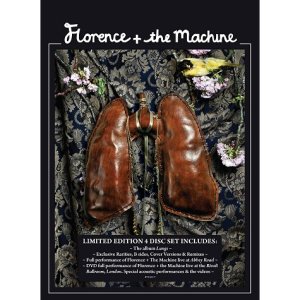
Leather, flowing fabric, visible stitching, vines, fruit, birds. Most importantly, look at the fabric that comprises the background. If not directly William Morris it is most certainly supposed to evoke his designs:
The flowing, simple, natural and repetitive patterns of Morris’s designs were replicated here, at this performance. Unlike the album art, I don’t think the stage backdrop is a specific Morris design. What is is however – and what is more interesting to me – is a contemporary design that is clearly re-employing a Victorian design in order to say something about the here and now. Note, also, the presence again of that draped sleeve, as well as more flowers on the microphone stand:
The flowers are sunflower-esque, emphasising that Florence’s aesthetic is a mish-mash of styles. The yellow sunflower was symbolic of decadence and dandyism, and surfaced again in Art Nouveau (closely related to Arts and Crafts). Like pre-Raphaelism and Arts and Crafts, however, Art Nouveau also ‘looked back’ for inspiration. It’s the ‘looking back’ that is in itself an aesthetic position.
Remember that Arts and Crafts appealed to the neo-Gothic characterisation of the Medieval craftsman? Check out the men in this shot, taken from the video to Rabbit Heart (Raise it Up):
It’s not a point-perfect re-enactment of medieval times, sure, but pig’s head, page-boy-esque stylings, minstrels in the background? That’s enough to be getting on with! The figure of the ‘page’ is a particularly easy way of making a contemporary reference to heraldry, the designs of which influenced Arts and Crafts practitioners:
What really intrigues me about this video still is that is alludes to the transition between neo-Gothic and Arts and Crafts. Look to the right of the picture, between then final couple, on the table there. See those jugs? They’re not neo-Gothic but they most certainly represent neo-Gothic’s closest movement, Arts and Crafts:
The looping handles and elongated features are indicative of the ‘handmade’ quality that Arts and Crafts wanted to capture. Both the decanter and the teapot feature visible joins – we can see where the handle meets the body, for example. Not only are the joins visible, but they are a decorative feature.
I couldn’t find a very clear shot of the head-dress that Florence is wearing, but in the banquet scene and the one below, the most obvious comparison would be to the famous pre-Raphaelite Ophelia (indeed, the Rabbit Heart video features a scene in which Florence, dressed as she is below, is lowered into the river).
But remember I said Morris was influenced by Ruskin? And, if you image search for paintings of both ‘Lady of Shalott’ and ‘Ophelia’ (John William Waterhouse and John Everett Millias, and Holman Hunt are names you should look for), you’ll see that the headcoverings of all the women are minimal. So we have to look elsewhere for inspiration:
The loops and whirls of the design are strongly reminiscent of the embroidery designs of May Morris:
Yes, Florence is standing near water in a long gown. Yes, she is standing near weeds. Yes, she has red hair. But does that really mean we have to reach for the Rossetti? Rushes, ferns, and water are all Arts and Crafts as well, you know…
What conclusions can I draw from this post? Well, it’s clear that the artwork and promotion for Florence’s debut album invoked tropes, styles and motifs from three main artistic movements: pre-Raphaelite, neo-Gothic, and most interestingly for me, Arts and Crafts. The close interaction of these styles – William Morris fabrics on the album cover, a devotion to the curves and visible construction of the movement, the allusions to neo-Gothic and Arts and Crafts in the same shot, for example – suggests that these choices are deliberate.
Who really knows why? I propose that actually, the motivations behind this choice are less interesting than the fact that it happens at all. It’s enough to know that the ‘looking back’ that we find in this post can be constructed from a swatch of fabric here, a jug on a table there, a pig’s head front and centre. This, to me anyway, is a clear sign of how powerful these Victorian movements were. Even though we think we’ve forgotten them, they’ve wormed their way into our collective consciousness.
Plus, they’re beautiful objects with a socialist twist. The UK could do with a lot more of that right now, say I!
_______________________
*Wikipedia – yes, I know – states that the ‘Arts and Crafts style was partly a reaction against the style of many of the items shown in the Great Exhibition of 1851, which were ornate, artificial and ignored the qualities of the materials used’. There’s that Great Exhibition again!

